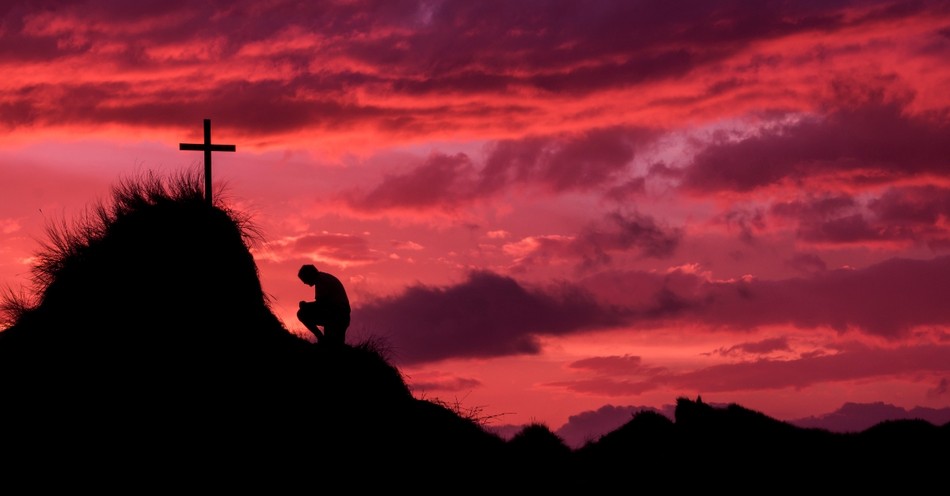Kneeling in prayer is an ancient practice with considerable purpose. A posture that comes with its own rich historical and biblical background.
So much so, it would be a travesty for the true purposes of kneeling to get lost behind tradition. Or worse yet, if the practice were dismissed and abandoned by the Christian, altogether.
Thankfully, by meditating upon the intended purposes of kneeling before the Lord, within the contexts of origin, an essential aspect of Christianity appears.
And it is here we’ll find a form of meaningful prayer and worship that can (and arguably should, whenever possible) be entered into with pleasure and with honor.
The Origins of Kneeling in Prayer
Historically, kneeling to bow at the feet of another was common practice in the ancient world, a universal sign of submission, honor, and respect.
For this reason, it was once expected that people would kneel in the presence of kings. Even taking a knee before anyone of higher authority to whom they sought a word or favor, simply because it was culturally normal to do so.
Beyond this portrayal of humble reverence, however, is the connection between kneeling and worship.
This could possibly be related to the fact that kings were often regarded as deities, but it’s also a concept seen in the Hebrew word for “worship” itself.
The word literally means “to bow down.” Something that would have been done from the kneeling position.
Biblically, God chose a man named Abram from this culture to be different. His family purposefully set apart from the ingrained worship of people and man-made idols around them. Here they found themselves being made holy, by God and for God (Deuteronomy 7:6).
Of course, old habits die hard, as this showed to be one of the greatest struggles portrayed within the Old Testament.
It was only with great patience, love, and care, that God repeatedly revealed he alone was worthy of such worship, honor, and praise.
Somewhere throughout this process, the practice of kneeling to worship people and things became a sacred kneeling to God, the creator of all people and things.
For God’s people, kneeling was now one way to worship Him, while entering into prayerful dialogue from that same place of submission, honor, and respect.
The Real Purpose of Kneeling in Prayer
Since that time in history, many instances of kneeling in prayer have been recorded for us in Scripture.
Still, historical and biblical tradition falls to the bottom of what should motivate any Christian to practice such things.
It is only by going beyond traditional inspiration that the real purpose of kneeling begs to be considered. Here are five such considerations:
1. Kneel in prayer for the purpose of worshiping God. In Revelation 19:10, the Apostle John is seen falling to his knees at the feet of an angel. The angel’s immediate response, “Don’t do that! …Worship God!”
The same connection is made here that is made elsewhere in the Bible — kneeling often accompanies worship.
In the same way, kneeling in prayer, spiritually at the feet of God, is a form of inspired worship. It may actually be one of the best ways to physically and tangibly display the profound respect and deep awe that engulfs a reverent heart in prayer.
Come, let us bow down in worship, let us kneel before the Lord our Maker! For he is our God, and we are the people of his pasture...(Psalm 95:6-7).
Let us offer to God acceptable worship, with reverence and awe, for our God is a consuming fire (Hebrews 12:28-29).
2. Kneel in prayer for the purpose of acknowledging God's holiness. Romans 11:33 implies that our knowledge of God is never-ending, his ways incomprehensible.
It may be that God’s holiness, his set-apartness, is unfathomable from our perspective. But we know there is none holy like the Lord (1 Samuel 2:2).
This is one aspect of God’s character that must go beyond general head knowledge to a place of relevant heart knowledge. A natural transition that occurs upon time spent with God, prayerfully and in his Word.
Without such conviction, kneeling in prayer can seem like an uncomfortable waste of time. But with it, kneeling can again become a physical and tangible display. This time, of God’s position in one’s life.
Furthermore, since kneeling encompasses the spirit of submission, reverence, and humility, it exhibits the attitude our most holy God is due.
The precise attitude his presence naturally reveals within the heart that seeks him, and the attitude he ultimately requires.
A time is coming and has now come when the true worshipers will worship the Father in the Spirit and in truth, for they are the kind of worshipers the Father seeks (John 4:23).
[Isaiah] saw the Lord sitting upon a throne, high and lifted up; Above him stood the seraphim… One called to another and said: “Holy, holy, holy is the Lord of hosts; the whole earth is full of his glory!” And the foundations of the thresholds shook at the voice of him who called... [Isaiah] said: “Woe is me! For I am lost; I am a man of unclean lips, and I dwell in the midst of a people of unclean lips; for my eyes have seen the King...” (Isaiah 6:1-5, ESV).
3. Kneel in prayer for the purpose of intention. As far as the Lord is holy, man is… not. This is one reason kneeling in prayer can become practically beneficial because let’s face it, distraction and broken intentions plague us all.
Maybe this is one reason Jesus taught his disciples to pray in secret, behind closed doors, himself frequently withdrawing to pray (Luke 5:16). Presumably, He also knelt to do so, though it was only visibly recorded once (see Luke 22:41).
Either way, it's in quiet solitude where Christians can more easily pray, with uninterrupted intention. Even benefiting from the increased focus that comes with kneeling, and its rewards like no other.
Go into your room and shut the door and pray… And your Father who sees in secret will reward you (Matthew 6:6).
For thus says the One… who inhabits eternity... “I dwell in the high and holy place, and also with him who is of a contrite and lowly spirit, to revive the spirit of the lowly, and to revive the heart of the contrite (Isaiah 57:15).
4. Kneel in prayer for the purpose of posture’s effect. Truth is, physical posture has a way of affecting mindset while mindset has a way of affecting posture.
Who doesn’t feel more confident walking through a crowd with their head held high, or start visibly sulking when upset?
Likewise, kneeling in prayer has a way of connecting the body, heart, and mind. This is why a kneeling prayer posture is uniquely able to enforce intention, facilitate confession, and promote humility.
All while supporting an attitude of meekness (Matthew 5:5), weakness (2 Corinthians 12:9), and reverence (Hebrews 12:28).
Each of these, a vital component to biblical worship and prayer, and each of these, modeled ever so nicely in the kneeling approach to prayer.
Be doers of the word, and not hearers only… (James 1:22).
Present your bodies as a living sacrifice, holy and acceptable to God, which is your spiritual worship (Romans 12:1).
5. Kneel in prayer, for Christ is King. Since Christ is the King of kings and Lord of lords (Revelation 19:16), the One to whom all authority has been given (Matthew 28:18), kneeling is a natural and appropriate response.
A truth soon to be widely realized on that day when every knee shall bow (Philippians 2:9-11).
What a privilege it is to approach God’s always accessible throne, through Christ who’s seated at his side (Hebrews 10:12).
Not out of obligation, but desire, the result of a graciously regenerated heart — only then so deeply inclined.
For he is Lord of lords and King of kings, and those with him are called and chosen and faithful (Revelation 17:14).
Let us therefore come boldly to the throne of grace, that we may obtain mercy and find grace to help in time of need (Hebrews 4:16, NKJV).
A Time for Kneeling
It’s important to keep in mind that there are many kinds of prayer, with many different postures — each one an acceptable and lovely way to pray.
Especially for those physically unable to kneel, remember, it is the heart’s posture that matters most.
Kneeling, however, has the longest historical purpose of greeting or petitioning one’s lord or king. While also having the widest biblical purpose of reverent and humble worship.
Therefore, rightly kneeling in prayer, will never be done in vain. In fact, it’s an honor to freely approach our King, to spend time in his presence through worship, or to bring an important plea that only He can gratify.
For these reasons, a kneeling prayer is a purpose-filled prayer.
For further reading:
Is Contemplative Prayer a Biblical Principle?
What Are the Benefits of Prayer?
What Is the Definition of Prayer?
What Types of Prayer Are in the Bible?
How Do We Love the Lord with All Our Hearts, Souls, and Minds?
How to Pray: A Biblical Guide to Prayer
Photo Credit: ©iStock/Getty Images Plus/GordonImages

This article is part of our prayer resources meant to inspire and encourage your prayer life when you face uncertain times. Remember, the Holy Spirit intercedes for us, and God knows your heart even if you can't find the words to pray.
Prayers for Healing
Morning Prayers
Prayers for Family
Prayers for Surgery
Prayers for Strength
Night Prayers Before Bed
Prayers for Protection
The Lord's Prayer: Our Father




